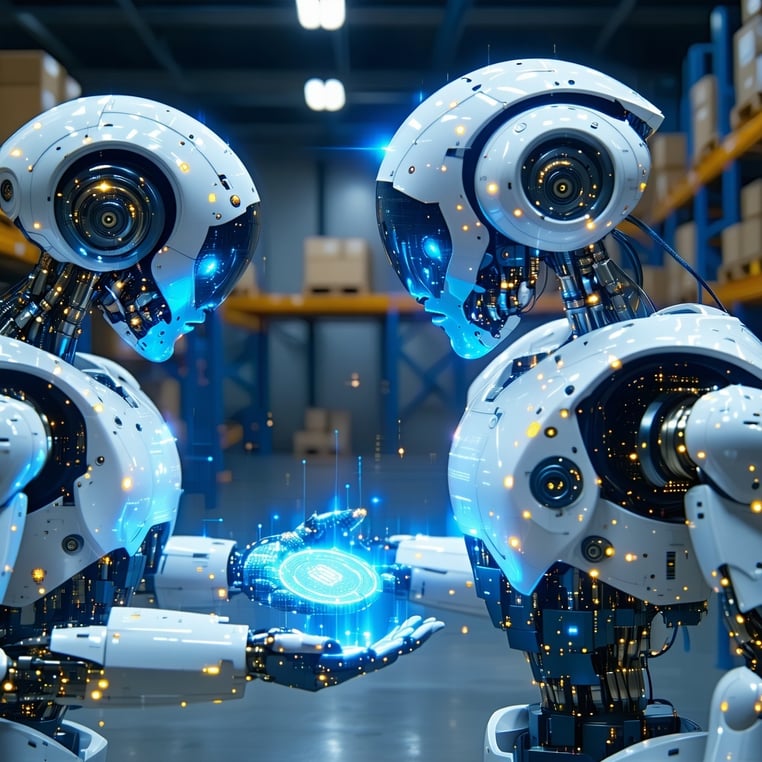How AI Is Transforming Authentication in Cybersecurity

AI is no longer confined to massive central servers. It is now making decisions and taking actions closer to us—embedded in drones, self-driving cars, smart homes, and edge devices. In this new era, can traditional authentication methods still meet the demands of the time?
Many believe that authentication must evolve alongside modern technology. This brings us to a critical question:
“How should AI agents—like offline humanoid robots or swarm robots—prove their identity?”
AI Agents Operating Independently and Collaborating
We are entering an era where AI no longer simply assists human users but operates as an autonomous entity.
- AI controls fleets of drones.
- Automated Guided Vehicles (AGVs) in warehouses adjust tasks independently.
- Edge devices identify and act locally without relying on external servers.
These agent-based, distributed AI systems cannot function effectively without trust-based collaboration. And at the heart of trust is authentication.
Picture a logistics warehouse where dozens of robots and AGVs work to sort and transport goods. If they had to authenticate with a central server each time, any network failure could halt operations entirely.
Instead, we need an environment where AI can make decisions, act independently, and collaborate with other AI systems. Think of robots meeting for the first time—building trust through a common 'language.' In other words, authentication now needs to function in a peer-to-peer (P2P) manner.
The Role of Edge Devices in the Age of AI
Edge devices—operating at the forefront of AI applications—must support autonomous authentication. If every action requires cloud-based verification, the system becomes inefficient and potentially dangerous.
““Is this person authorised to enter?”
“Can I change lanes now?”
Delays in response could quickly lead to critical failures.
![]()
Current authentication methods weren’t built for this. Traditional approaches rely on outdated assumptions:
- A user supplies credentials (passwords, biometrics, etc.).
- There is a central server (e.g. PKI, FIDO, Passkeys).
- The system is always connected (real-time request-response structure).
In the AI era, those assumptions no longer hold:
- AI must authenticate without human involvement.
- Edge devices may be offline.
- Autonomous systems need to verify each other instantly.
Technologies like PKI, FIDO, and Passkeys fall short in these scenarios:
- Certificate sharing and verification are slow and complex.
- Small edge devices face heavy computational loads.
- No server connection means no authentication.
OTAC – Revolutionising Authentication for the AI Era
OTAC (One-Time Authentication Code) is designed for the decentralised, AI-driven future. This groundbreaking technology follows principles that break away from traditional models.
|
Principle |
Description |
|
Token generation at the client |
AI generates the token independently, with no server contact. |
|
One-way communication |
The token is transmitted in one direction for verification—no interaction required. |
|
No real-time connection needed |
Tokens can be generated even when offline. |
|
Simultaneous identity and legitimacy |
A single dynamic code verifies both identity and authorisation. |

OTAC is enabling AI systems and connected devices to prove their identity and trustworthiness on their own. It represents a shift towards truly decentralised, resilient authentication—tailored for the next generation of intelligent machines.
--------------------

Author: Chang-Hun Yoo, Inventor of OTAC | Cybersecurity & Authentication Expert
The inventor of OTAC (One-Time Authentication Code), he is a recognised expert in cybersecurity and authentication technologies. With over two decades of experience in enterprise security, identity management, and encryption systems, he has driven innovation across sectors including document security, edge computing, and AI-based authentication. His work is shaping the future of secure, decentralised identity in the AI era.
--------------------

swIDch will continue its quest to innovate and pioneer next-generation authentication solutions. To stay up-to-date with the latest trends sign up to our newsletter and check out our latest solutions.

In late April 2025, Spain and Portugal were hit by one of the most extensive power outages in recent European history.

The distributed control system (DCS) is the core of industrial automation. It synchronises critical operations in power

In the age of digital transformation, cybersecurity has become a boardroom topic across industries. But while IT
Looking to stay up-to-date with our latest news?